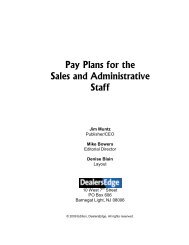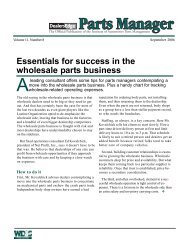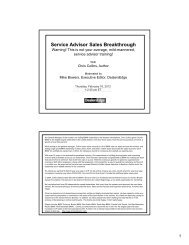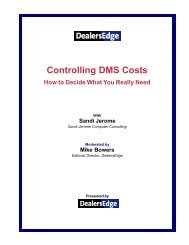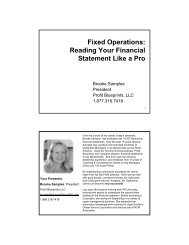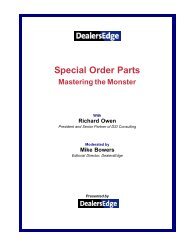How To Avoid Physical Parts Inventory Nightmares - DealersEdge
How To Avoid Physical Parts Inventory Nightmares - DealersEdge
How To Avoid Physical Parts Inventory Nightmares - DealersEdge
You also want an ePaper? Increase the reach of your titles
YUMPU automatically turns print PDFs into web optimized ePapers that Google loves.
27. Emergency Purchases or Receipts + Customer Special Orders. This figure represents aslightly different approach than calculations used in the past. Here we are adding customerorders that were placed on the stock order (smart move by the parts manager) yet representhybrid emergency purchases. There is a fine line drawn here in that many of the DMS systemsallow a variety of receipt and posting codes for parts that are, by definition, emergencypurchases. The fact that a daily stock order exists allows the parts manager to put these on thestock order. They are not for stock, but for a specified customer; they are a hybrid emergencyreceipt or purchase.A loose guide would be that less than 10-15% of all orders should be emergency orcustomer special orders.The piece count of emergency receipts and customer special orders is used for the FOScalculation on line 29.28. Lost Sales demand is one of the most critical pieces of information the system needs inorder to calculate suggested orders more accurately, within the established buying guides, andto monitor testing parts that might, eventually, need to be actively stocked to the shelves.A lost sale is a demand, from anyone, that does not result, at the time of demand, in a sale ofthe part; the customer leaves or hangs up the phone and that specific transaction is ended.Despite the reasons for the lost sales, all of them must be posted to the system.There are three types of lost sales demand. Two of these types can be tracked and posted inthe parts department, at the time of demand. The third type of lost sales is still a problem formost DMS systems and Factory Distribution Systems since it represents untraceable demanddone electronically without leaving a trail of the demand in the parts department. The threetypes of lost sales are:1. Lost sale based on availability⎯over all the most frequent type.2. Lost sales on the cost of the part⎯customer hangs up and goes elsewhere3. Electronic locator systems⎯demand from others that leaves no trail of thedemandIt is critical that all parts personnel that talk with the customer on the phone or at the counters betrained to post all lost sales. In the calculation for FOS the pieces lost is used.The guidelines here are from two databases. One is from a database of over 10,500 dealerrecords and represents an average of lost sales posted per person per day; it is: 2-3/person/day. Average is not much good here because it does not designate what is possiblewhen careful attention is paid to the posting and recording of lost sales.From a ‘select database’ of 105 dealers who, by observation, do the job nearly 100%, the rate is5-8 /person/day. The more accurate guideline is simply to post all lost sales. Remember: It isnot the existence of lost sales that is a problem; it is the absence of lost sales that shouldconcern the managers of the dealership.29. Filled from Stock Ratio - also called Fill-off-the-shelf (FOS) has become the mostaccurate formula for measuring the effectiveness of the parts inventory in satisfying the demandof the technicians and customers, on demand, thus making the technicians more efficient andprofitable and increasing the customer service satisfaction measurements in the dealership.Unlike the older level of service calculation, the calculation for FOS adds an additional piece inthe formula and uses pieces and not part numbers or dollars. The formula is as follows:Fill off the Shelf = <strong>To</strong>tal Demand – [(Lost Sales) + (Emergency Purchases & Special Orders)]8




